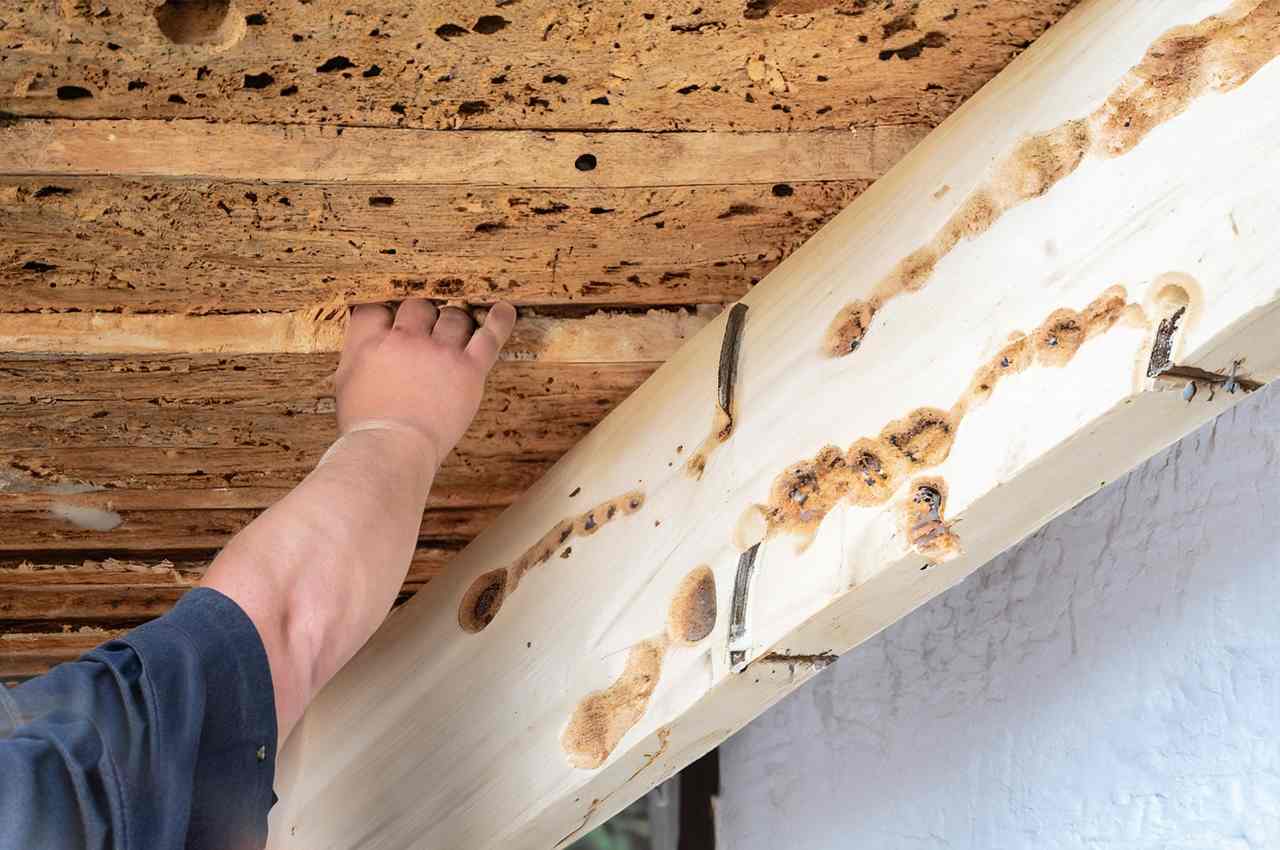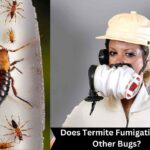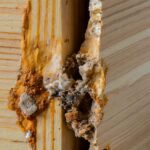If you’re thinking on how to replace termite damaged roof rafters, the following guidelines will make the process simple and secure. Repairing roof rafters that have been ruined by termites is essential if you want to keep your house structurally sound and stop more damage. Termites may wreak havoc on a roof’s wooden components, jeopardizing the integrity of the roof and perhaps endangering the whole structure. The basic procedures and factors involved in replacing termite-damaged roof rafters will be explained in this tutorial.
We’ll give you a thorough overview to ensure a smooth and secure rafter repair procedure, including everything from spotting termite damage to choosing appropriate replacement materials and deciding whether to do it yourself or hire a specialist.
How to replace termite damaged roof rafters?
To replace roof rafters that have been affected by termites, start by assessing the damage’s degree and creating a restoration strategy that may involve both rafter replacement and termite-resistant wood treatment. Gather the necessary equipment and supplies, such as fresh rafters, rafter supports, nails, screws, wood glue, a saw, a level, a tape measure, safety glasses, gloves, and a dust mask.
Remove the afflicted rafters while protecting the surrounding timber, then carefully disassemble the roofing materials to reveal the damaged region. The new rafters should be cut to the proper length, installed level, and securely fastened with nails or screws. Apply wood glue to joint locations and think about adding bracing or rafter supports to reinforce structural integrity. Examine the final replacement carefully and make any required changes for a sturdy and long-lasting repair.
Understanding Termites and Their Impact on Roofs
Termites are pests that devour wood and may seriously harm roofs, rafters, and other wooden buildings. They may be found everywhere, although they are most active in warm, humid regions. A house may get infested with termites via the foundation, windows, or doors. Once inside, they will hollow down the wood to form tunnels and galleries where they may feed on the cellulose.
Quick intervention is necessary to stop termite damage to roof rafters from becoming worse. It is crucial to get your house evaluated by a professional if you believe you have a termite infestation. Less harm will be done if the infestation is addressed quickly.
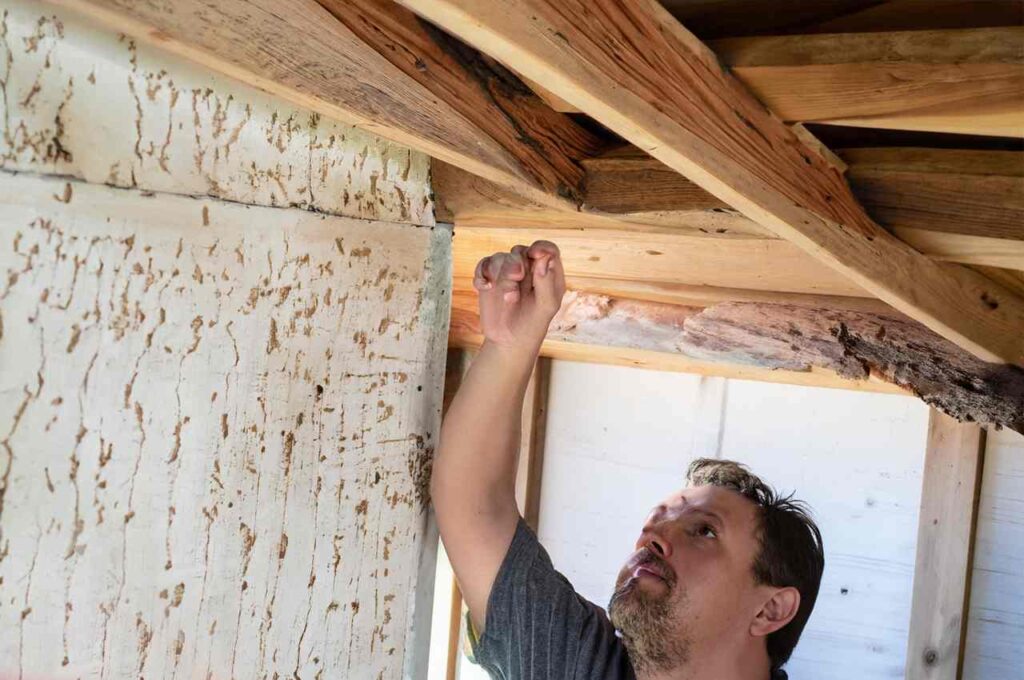
Identifying Termite Damage
Here are some of the signs of termite damage that you can look for:
| Sign of Termite Damage | Description |
|---|---|
| Dark wood dust | Around windows, doors, and active infestation sites, termites create a black, sawdust-like frass. |
| Hollow sound | Termites have eaten away at the inside of damaged wood, leaving a shell that makes the board sound hollow when tapped. |
| Mud tubes | Termites build mud tubes to get from the ground to afflicted wood; these tubes are observed on external walls. |
| Discarded wings | Termites lose their wings after mating. An active termite infestation is indicated by the discovery of wings inside. |
| Swollen or cracked wood | Wood may expand or split as a consequence of termite activity, dampness, or decay, or both. |
| Soft, spongy wood | Termites damage roof rafters, making them spongy. This may harm roof structure. |
It’s crucial to remember that not every instance of termite damage may exhibit all of these symptoms. Have a professional check your house if you think you may have termites to establish the extent of the damage.
Steps for Inspection
The following actions will be required for a comprehensive inspection:
| Inspection Steps | Description |
|---|---|
| Visual inspection of exterior and interior | Look for termite damage indicators such as mud tubes, frass, and hollow noises. |
| Drilling into wood | Drill holes into wood to check for termite activity. |
| Using a moisture meter | Check the moisture content of the wood since termites are drawn to wet areas. |
| Using thermal imaging camera | Look for heat signals that could indicate termite activity. |
The inspection’s findings will assist the expert in estimating the amount of the termite damage and creating a treatment strategy.
Preparing for Rafter Replacement
| Inspection Steps | Description |
|---|---|
| Visual inspection of exterior and interior | Look for termite damage indicators such as mud tubes, frass, and hollow noises. |
| Drilling into wood | Drill holes into wood to check for termite activity. |
| Using a moisture meter | Check the moisture content of the wood since termites are drawn to wet areas. |
| Using thermal imaging camera | Look for heat signals that could indicate termite activity. |
Steps to Replace Termite-Damaged Roof Rafters
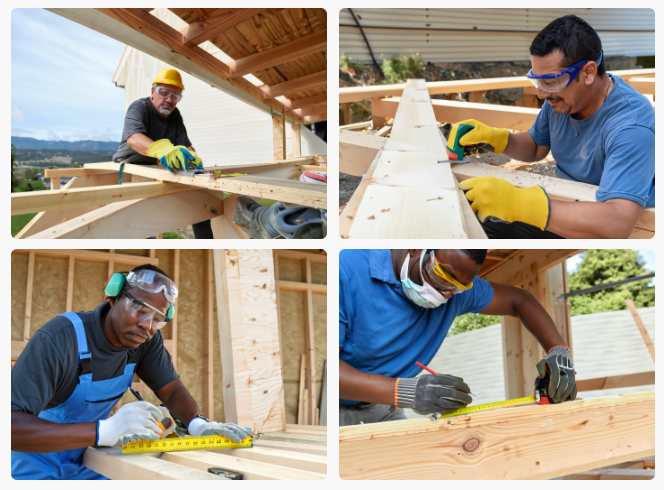
| Steps | Process | Description |
|---|---|---|
| 1 | Assessing Damage and Planning | • Inspect the damage using a flashlight, looking for signs of termite damage like frass, mud tubes, or hollow spots. |
| • Plan the repair process considering whether to replace damaged rafters, treat with preservative, or both. | ||
| 2 | Gathering Materials and Tools | • Gather necessary materials such as new rafters, rafter supports, nails, screws, wood glue, saw, level, tape measure, safety gear. |
| 3 | Removing Damaged Rafters | • Safely remove roofing materials covering damage using ladder/scaffolding. |
| • Carefully cut and remove damaged rafters while avoiding harm to surrounding wood. | ||
| 4 | Installing New Rafters | • Cut new rafters to size, ensuring level installation. |
| • Secure new rafters with nails/screws and apply wood glue to joints. | ||
| • Reinforce roof integrity by installing rafter supports or bracing the new rafters. | ||
| 5 | Reinforcing Structural Integrity | • Install rafter supports to distribute roof weight evenly. |
| • Brace rafters to prevent sagging or bowing. | ||
| • Use durable wood for new rafters. |
Cost Replacing termite-damaged roof rafters
Several factors, such as the degree of damage, the kind of wood used, and the location of the property, might affect the price of rebuilding termite-damaged roof rafters.
The typical price to repair a termite-damaged roof rafter is $1,200, according to HomeAdvisor. The price, though, may run anywhere from $500 to $2,500 or more.
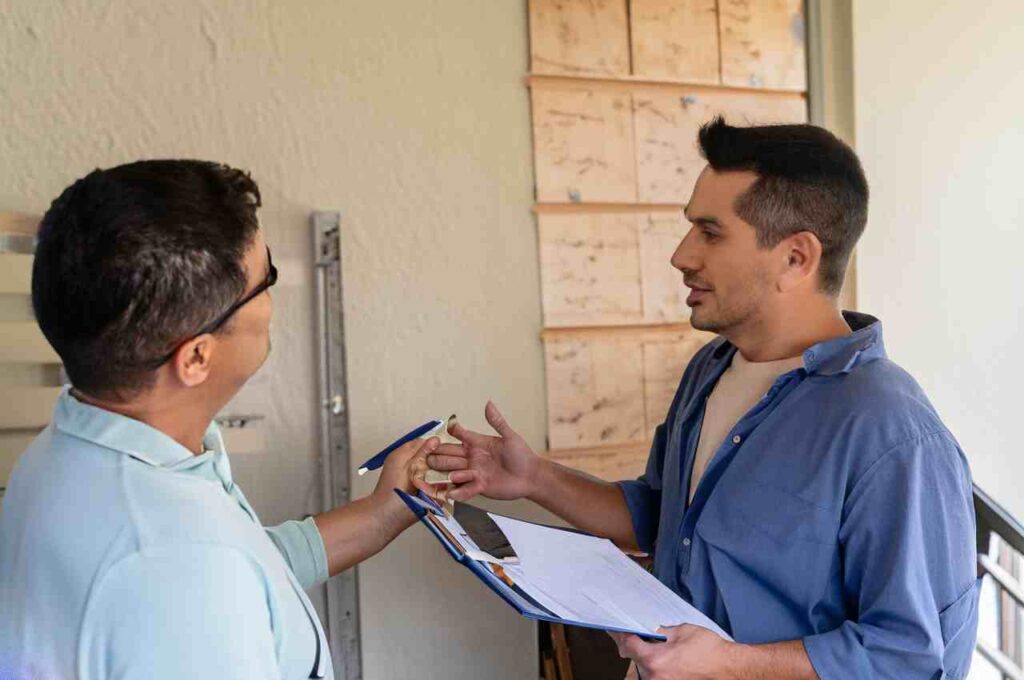
Some of the elements that may impact the price of replacing roof rafters with termite infestation are listed below:
- The amount of the damage: The cost of repair is greater the more severe the damage.
- The kind of wood used: Depending on the type and grade, wood prices might change.
- The home’s location: Depending on the home’s location, labor costs might change.
- The cost of permissions and inspections: Depending on where the house is located, permits and inspections may be necessary.
Here is an approximate price range for replacing roof rafters with termite damage:
| Item | Estimated Cost |
|---|---|
| Rafter | $500 |
| Labor | $700 |
| Permits and Inspections | $200 |
| Total | $1,400 |
The exact cost might be different since this is just an estimate. Before making a choice, it’s crucial to receive many quotes from experienced pros.
Preventive Measures
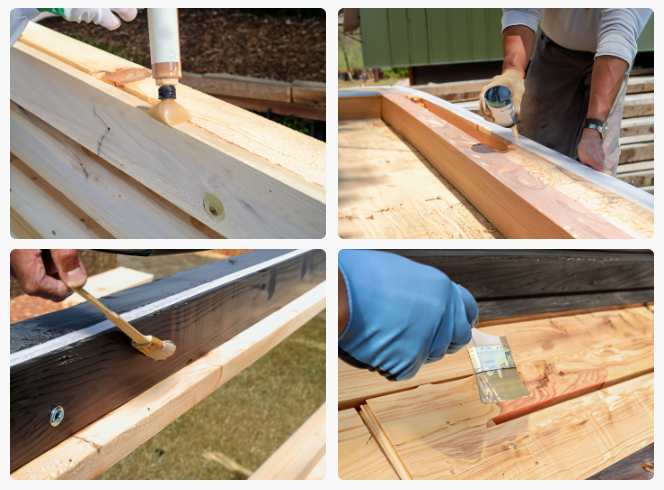
Here are some tips for preventing future termite infestations:
- Maintain a dry house. Keep in mind that termites need moisture to live, so make sure your house is dry. This entails repairing any leaks around windows and doors and checking the drainage of your gutters and downspouts.
- Eliminate all termite food sources. It’s crucial to get rid of any sources of food from your house since termites consume wood. This entails keeping wood waste away from your house and storing firewood away from it.
- Repair any foundational cracks or gaps in your house. Small gaps or holes allow termites to infiltrate your house. Use caulk or sealant to fill up any gaps or cracks in your foundation.
- Construct a termite fence. A physical barrier known as a termite barrier keeps termites out of your house. It may be constructed from plastic, metal, or concrete.
- Apply a termite-resistant preservative to your house. Your house may be protected against termites with the aid of a termite-resistant preservative. If you reside in a region where termites are widespread, this is very crucial.
- Regularly check your house for termite damage. This entails searching for frass, mud tubes, and hollow areas of the wood. It’s crucial to have a professional evaluate your house if you see any of these symptoms.
By implementing these suggestions, you may help stop further termite infestations and shield your house from harm.
Here are some extra pointers:
- Grow bushes and trees far from your house. The moisture and shade that trees and bushes provide are attractive to termites.
- Avoid piling firewood up against your house. Firewood may serve as both a food supply and a gateway for termites to enter your house.
- Keep your yard clutter-free and spotless. By doing this, termites will be less likely to locate a location to establish a nest.
- Even if you don’t live in a region where termites are abundant, get your house evaluated for termites every few years.
You may help prevent termites out of your house by heeding these advices.
Importance of Seeking Professional Help
Expert help is recommended if termites have seriously damaged your roof rafters. The replacement of roof rafters that have been harmed by termites is a difficult task that calls for expertise. A specialist will be able to evaluate the degree of damage, create a strategy for restoration, and securely and successfully replace the damaged rafters.
Termites have caused considerable damage to roof rafters, which is why it’s crucial to get expert assistance:
- Professionals have the knowledge and expertise necessary to repair the damaged rafters in a secure and efficient manner. They will be familiar with the right methods for removing the damaged rafters and replacing them. Additionally, they will be able to strengthen the roof’s structural stability.
- Experts have access to the necessary tools and resources. They will have the ladders, scaffolding, and other gear required to repair the damaged rafters in a secure and efficient manner.
- Experts are knowledgeable about the most recent technologies and approaches for curing termite damage. To fix the harm and stop other infestations, they will be able to use the best techniques.
Conclusion
By assessing the damage and coming up with a restoration strategy that can include termite-resistant sealants, you can replace termite-damaged roof rafters. The following materials are required: fresh rafters, supports, nails, screws, wood glue, a saw, level, tape measure, safety goggles, gloves, and a dust mask. Remove damaged rafters and carefully remove covers using a ladder or scaffolding. Install fresh rafters by measuring, cutting, and leveling them before nailing or screwing them in. For structural stability, add bracing or rafter supports. To ensure stability and lifespan, review the repair and make any necessary modifications.
Frequently Asked Questions
Can termite damaged roof rafters be replaced?
Replacement of termite-damaged roof rafters depends on the amount of the damage. Minor damage may need repairs, while substantial damage may necessitate rafter replacement or roof replacement. The roof’s age, maintenance, and replacement expenses should be evaluated. A competent specialist must analyze termite damage to roof rafters and advise on the best course of treatment.
What is the average cost for replacing termite-damaged roof rafters?
Depending on the level of damage and wood type, termite-damaged roof rafters might cost $500 to $2,500 or more to repair. Damage severity, wood quality, labor prices by location, and permit and inspection charges affect costs. Replacing termite-damaged rafters may cost $1,400, including $500 for rafters, $700 for labor, and $200 for permits and inspections. These statistics are estimates, therefore get several quotations from certified specialists to truly analyze expenses.
Is termite-damaged roof rafters covered by insurance?
Standard homeowners insurance does not cover termite-damaged roof rafters. Termite damage is slow and preventive, but homeowners insurance covers abrupt and unintentional catastrophes. If the damage is caused by a covered occurrence or your insurance includes termite protection, there may be exclusions. To determine whether termite damage is covered, thoroughly study your homes insurance policy. Termite-damaged rafters may be covered, although approval and conditions may include deductibles and rate modifications.
How do you fix a rotted roof rafter?
Rotted roof rafters may be repaired in numerous ways depending on their severity and wood type. Patching with fresh wood may fix minor damage, but more serious damage may need metal braces and expert help. A full replacement, albeit more expensive, is usually ideal for extensive damage. Repair damaged wood, cut a matching piece, screw or nail it in place, and seal it to prevent moisture.
How do I assess termite damage to roof rafters?
Termite damage to roof rafters requires identifying infestation indications. Look for hollow patches in the wood produced by termites chewing away at it, making it brittle. Termites migrate via mud tunnels linking the earth to the wood. After mating, flying termites indicate an infestation. Frass, a sawdust-like residue, may also indicate termites. Identifying these symptoms helps quickly and successfully repair roof rafters damaged by termites.
What materials and tools are required for replacing termite-damaged rafters?
To replace termite-damaged rafters, you’ll need new rafters that match the original wood type, rafter supports for reinforcement, nails or screws to secure them, wood glue for joint sealing, a saw to cut them to size, a level to align them, a tape measure to measure them, safety glasses to protect your eyes, gloves to protect your hands from splinters, and a dust mask to protect your inhalation. Use the right materials and equipment, and if you’re not comfortable with woodworking or heights, hire a specialist.
How do I safely remove roofing materials covering damaged areas?
Follow these methods to securely remove damaged roofing materials: Assessment the damage to determine the extent of work. Depending on the material, use a roof rake or pry bar. Avoid damaging gutters and downspouts. Wear a hard helmet, safety glasses, and gloves for safety. Always operate from a ladder or scaffolding to avoid falls.
What precautions should I take while cutting damaged rafters?
When cutting damaged rafters, take precautions: Protect your eyes and hands from debris with safety glasses and gloves. Choose a sharp saw for smoother cuts and less splintering. Cut one rafter at a time to avoid sudden falls. Have a helper to support rafters and manage debris. Be careful not to damage the roof deck or gutters. To reduce risks, dispose of cuttings properly.
How do I cut and install new rafters securely?
Cut and install new rafters securely using these steps: Make sure the new rafters match the old ones by cutting them to size. Secure the new rafters to the supports using nails or screws. Wood glue the new rafters’ joints for stability. Use a level to level the new rafters. Carefully check the repair after installation for security and stability. This order will assist install new rafters securely.
What procedures may I utilize to strengthen the roof following rafter replacement?
There are numerous ways to strengthen the roof following rafter replacement. Rafter supports—wood, metal, or concrete—provide vital strength. Similar-material bracing prevents rafter movement. Wood or metal trusses provide sturdy, efficient roof support. Steel and concrete beams are stronger and fire-resistant, but they cost more and need specific installation. The best approach depends on the scenario, and a structural engineer may advise you.
What signs indicate that a rafter needs to be replaced due to termite damage?
Hollow places, cracking wood, mud tubes, flying termites, frass (sawdust-like residue), drooping roof, and increasing water damage indicate termite problems and need rafter repair. If these indicators appear, professional examination is necessary. Visually examine for damage, use a flashlight, tap rafters for hollow noises, and use a moisture meter to measure wetness.
Can I treat the wood with a termite-resistant preservative before installing new rafters?
Treat the wood with a termite-resistant preservative before installing new rafters. This preventive strategy protects rafters against termite damage. For outdoor wood, borate, a naturally occurring termite-toxic chemical, is an alternative. Petroleum-derived creosote, harmful to termites, is advised for buried or water-contact wood. Copper chromium arsenate (CCA), previously useful but now harmful, is also discouraged. Make sure a termite-resistant preservative is approved for your location and follow the manufacturer’s directions.
Should I consult a professional if I'm unsure about replacing rafters damaged by termites?
Yes, termite-damaged rafters should be replaced by an expert. Professionals can precisely diagnose damage and repair it appropriately, maintaining your roof’s structural integrity. Given the risks and complexity of roof repair, specialists have safety training and the right equipment. Their knowledge and warranty options highlight the advantages of using their skills.
Which wood is best for new rafters to avoid termite damage?

Use naturally termite-resistant woods for new rafters to avoid termite damage. Douglas fir and southern yellow pine are valued for their qualities. Spruce, albeit lightweight, may work in low-moisture environments. Another tough, lightweight wood, hemlock resists rot and decay and thrives in low-moisture areas. Cedar, inherently insect- and decay-resistant, is good for insect-prone areas. Climate, moisture exposure, insect danger, wood weight, and cost are crucial when choosing a wood type to sustain the roof’s weight and preserve structural integrity. These woods are good for termite-prone areas because to their longevity and weather resistance. Using naturally termite-resistant timber in your new rafters helps protect your house against termites.
How do I identify load-bearing rafters before starting the replacement process?
The roof and ceiling of your house depend on load-bearing rafters. Refer to your home’s designs to find rafters perpendicular to the joists (which support the floor), those nearest to the external walls, and thicker and more robust rafters before replacing them. Professional advice is suggested if unclear. To support your roof and ceiling, replace load-bearing rafters with beams of the same size and strength.
Can I repair termite-damaged rafters myself, or should I hire a professional?
Whether you can fix termite-damaged rafters yourself or hire a professional depends on your DIY abilities, level of damage, height comfort, price, and time. If you’re good at woodworking, you can fix minor damage yourself, but major damage or inexperience should need professional help. Before making a choice, evaluate your skills, damage severity, and repair difficulty.
What type of wood is recommended for new rafters to prevent future termite damage?
For future termite protection, select naturally termite-resistant timbers for new rafters. Douglas fir and southern yellow pine are valued for their qualities. Spruce, albeit lightweight, may work in low-moisture environments. Another tough, lightweight wood, hemlock resists rot and decay and thrives in low-moisture areas. Cedar, inherently insect- and decay-resistant, is good for insect-prone areas. Climate, moisture exposure, insect danger, wood weight, and cost are crucial when choosing a wood type to sustain the roof’s weight and preserve structural integrity. These woods are good for termite-prone areas because to their longevity and weather resistance. Using termite-resistant timber in new rafters may protect your house from future termite troubles.
What is a cheaper alternative to rafters?
There are many affordable rafters with their own benefits. Trusses, prefabricated wood or metal constructions, are stronger and lighter. Steel beams are strong and fire-resistant, although they cost more than rafters. Concrete beams are strong and fire-resistant, but they cost more and need special installation. Laminated Veneer Lumber (LVLs) and Parallel Strand Lumber (PSLs) are strong and lightweight alternatives. Cost, material strength, weight, climate, and roof type should be considered while choosing an alternative, with structural engineer advice.
- How do termite mounds help regulate temperature? - 7 January 2024
- 10 Effective Termite Control Methods That Actually Work - 4 January 2024
- How Long Does It Take for a Termite Mound to Form? - 21 December 2023
